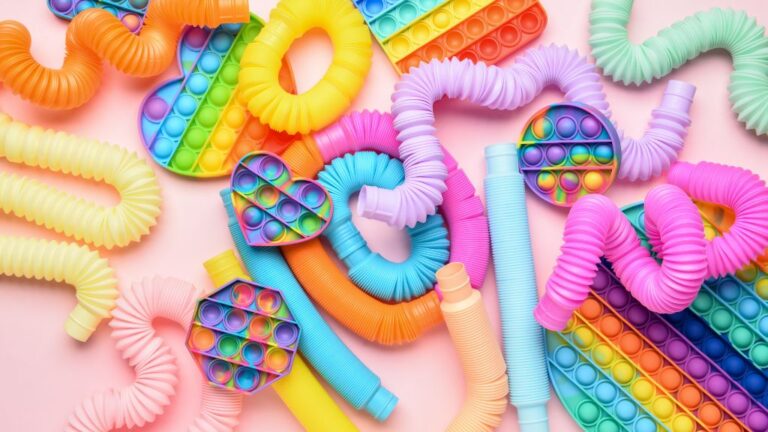Parents and caregivers of children diagnosed with autism spectrum disorder (ASD) know what it’s like to endlessly research the best resources to help them feel more comfortable, regulated, and supported throughout their day-to-day life. Creating a sensory tool kit is crucial for many individuals on the spectrum (and their parents). Especially as children and teenagers with ASD navigate new experiences or highly stimulating activities.
As experienced ABA therapy providers, ABA Centers of Florida is delighted to provide parents and advocates with critical advice and resources for building sensory tool kits for their kiddos with autism. Many ASD parents and ABA providers have perfected their sensory tool-building skills over time and feel over the moon with their results!
By building a sensory tool kit you can keep handy, you may minimize your child’s distress and increase the likelihood they’ll be more receptive to new adventures and flexibility around routine changes. Sensory tool kits often provide a valuable outlet during sensory overload and overstimulation.
A sensory tool kit nearby can help many individuals with ASD feel empowered and supported as they learn to self-regulate and express their needs via these practical tools. Most families eventually realize that building a sensory tool kit can be simple and manageable, especially with our expert advice. Keep reading this blog to learn more about ABA techniques, materials, and other valuable tips for creating your child’s sensory tool kit!
For more information about Autism Services with ABA Centers of Florida, click here.
Why Do Children with Autism Sometimes Have Sensory Sensitivities?
Individuals of any age with autism often experience sensory sensitivities and sensory difficulties. These experiences can be overwhelming for both them and their caregivers to manage. Sensory sensitivities can present in different ways, ranging from increased sensitivity to light, sound, touch, taste, and crowds. These sensory sensitivities can lead to physical and emotional discomfort, anxiety, and even meltdowns.
Many parents question why their children with autism have these sensory sensitivities. Research suggests that the underlying cause for these sensitivities in autism may be differences in how their brains process sensory information. As a result, sensory tool kits have become increasingly popular among parents and autism specialists like Board Certified Behavior Analysts (BCBAs), Registered Behavior Technicians (RBTS), to name a few.
Sensory tool kits provide individuals with autism access to different gadgets, souvenirs, and sensory experiences, such as activating toys and electronics, which help them regulate their sensory experiences and improve their overall sense of well-being.
Identifying Your Child’s Sensory Needs
As a parent, it can be challenging to understand your child’s sensory needs related to autism. However, identifying these needs can be crucial in improving their experiences and building an effective sensory tool kit. The good news is that the journey toward understanding your child’s sensory needs can be exciting and fulfilling. With plenty of patience and love, you can take the time to explore what aspects of their environment they enjoy and what causes them discomfort.
You know your child better than anyone else. But when it comes to autism spectrum disorder, identifying their sensory needs requires more attention to detail than many parents realize. Here are a few things to remember when observing your child’s response to sensory experiences. Consider the following:
- Does your child cover their ears when there’s a loud noise?
- Do they refuse to wear specific clothing because it doesn’t feel right?
- Are they bothered by bright lights or strong smells?
- Do they shut down when trying new foods?
These signs could indicate that your child has sensory processing difficulties needing support. But don’t worry. Tailoring sensory experiences to their unique preferences can lead to a more harmonious and relaxed life. Remember, there is always time to start identifying your loved one’s sensory needs. Embrace the process with energy, optimism, and hopefulness because your child’s development expansion rewards are endless!
What Is a Sensory Tool Kit? How Does It Support Regulation and Adaptability?
Self-regulation and the ability to relax are essential to well-being, especially if you constantly feel overwhelmed by surrounding sensory experiences. A sensory tool kit assembles the proven supplies that help clients achieve these states even when overstimulated – items that can provide tactile or visual stimulation to enable individuals with ASD to calm down or stay focused. By incorporating a sensory tool kit into routines, many with ASD can better manage their behaviors, enhancing future outcomes.
Creating an Effective Sensory Tool Kit
For those with sensory processing issues, navigating the world around them can sometimes be terrifying. Everything from the booms of lightning and thunder to the sounds of live music or certain (mainly new) textures can create anxiety-provoking symptoms. Managing sensory sensitivities can increase apprehension in parents and limit their outings. Fortunately, in many cases, sensory tool kits save the day!
Each child on the spectrum is entirely different and requires unique tools and approaches to help them feel confident and safe in their surroundings. Every sensory tool kit will be a bit different but will likely include several of the following:
- Fidget toys and spinners
- Weighted blankets, vests, and plushies
- Noise-canceling headphones
- Aromatherapy oils or sachets
- Textured objects
- Chewable jewelry
- Body socks
- Body brushes
- Stress balls
- Clay or hand putty
- iPad or electronic devices
Use each item differently to help soothe the body and calm the mind. By incorporating these essential items into your child’s sensory tool kit, they will be more prepared to face whatever the day brings.
Keeping Your Sensory Tool Kit Handy, Organized, and Engaging
Maintaining the organization of your child’s sensory tool kit requires as much thought as assembling it. By keeping the tools readily accessible and well-organized, your child will quickly grab them when needed. Consider using a clear container with different compartments or small bags to separate and label each tool in your sensory tool kit. You can create situational kits for specific events and needs. Creativity is encouraged when designing your loved one’s tool kit. By spending a little time upfront creating an organized system, you can help your child improve their sensory regulation.
Additional Resources to Enhance the Effects of Sensory Tool Kits
Sensory tool kits are a game-changer for many individuals who struggle with sensory overload and ASD. However, there are ways to make your child’s sensory tools even more powerful. Music is a fantastic resource when a child may feel overloaded, but recognize this tool isn’t best for everyone with ASD. Calming soundscapes or upbeat tunes can help create an even more immersive experience for many with ASD while promoting relaxation or engagement through movement, humming, or singing.
Ensuring your sensory tool kit is only sometimes available is also essential. It should feel special and limited to outings where they will be most helpful. Ensure you utilize your tool kit only when the child needs it. Overusing these tools can make them less engaging and motivating over time.
Another option is incorporating aromatherapy, as mentioned above. By adding essential oils or gentle scents to a sensory tool kit or soft pillow, individuals can harness the power of scent to soothe further or stimulate the senses differently. Again, as with our other suggestions, remember that all kids are different, so take time to try these ideas in small measures. Aromatherapy is not a preference for some.
In many cases, with a bit of careful experimentation, you will find the tools that work for helping your kid cope. Use your discretion when selecting toys and ensure they differ from your child’s current selection. These small additions and tips can significantly impact loved ones and help them get the most out of their sensory tool kit and play.
Do Sensory Tool Kits Make an Impact?
Research and anecdotal evidence establish that children with autism can experience a variety of sensory sensitivities manifesting in various symptoms. Parents can identify necessary resources to support their child during stress, anxiety, feeling overwhelmed, and other emotionally challenging moments. Establishing a sensory tool kit is a great, easy way for parents, teachers, and ABA practitioners to do this.
By gathering items like those we suggested and some of the latest autism gadgets on the market, many on the spectrum find immediate relief to help them in some of life’s most challenging moments.
More About ABA Centers of Florida
If you need additional help providing your child with the best possible autism care, reach us now to learn about our ABA services, like ABA therapy and Autism Diagnosis. ABA Centers of Florida is here to assist you in creating safe spaces for your child’s developmental growth that improve interactions and experiences. Additionally, we can help you develop systems and utilize tools that improve your child’s sensory processing experiences.
ABA therapy enhances life allowing everyone in neurodivergent families to achieve meaningful gains leading to ongoing positive experiences.
Call us now at (772) 773-1975 for more information or visit us here.








